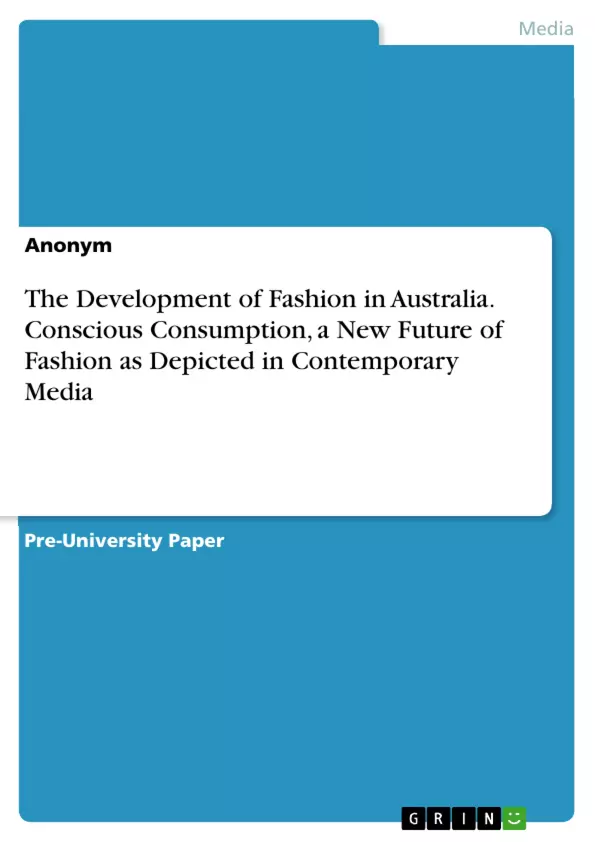This paper explores the increasing relevance of sustainability in Australia's fashion industry, sparked by the inaugural "Australian Circular Fashion Conference" held in Sydney in March 2018. This event marks a significant turning point in the country's engagement with sustainable fashion, aligning with a global shift toward more responsible consumption. Through an analysis of current trends, media coverage, and the insights of key industry figures like Camille Reed and Clare Press, the paper examines the growing awareness and commitment to sustainable practices within Australia's fashion ecosystem. The discussion highlights the challenges posed by fast fashion, including overproduction, waste, and exploitation, while addressing the economic drivers behind these issues. It also considers the rise of conscious consumerism and "green fashion," emphasizing that Australia is positioned to play a crucial role in shaping the future of global fashion sustainability. The paper underscores the importance of continued monitoring of these developments as the fashion industry adapts to the growing demand for ethical and sustainable alternatives.
Inhaltsverzeichnis (Table of Contents)
- Foreword
- The Development of Fashion in Australia
- The Beginning of Australian Fashion - The Roots
- Brief Explanation of Aborigines
- Indigenous Fashion
- Australian Fashion Progression
- Modern Times
- The Beginning of Australian Fashion - The Roots
- Consumerism + Fast Fashion
- Consumer Society
- The Development of Fast Fashion Industry
- Fast Fashion Industry
- Impacts of the Fast Fashion Industry
- Conscious Consumption + Slow Fashion
- Sustainable Fashion
- Conscious Consumerism
- The Development of Sustainable Fashion
- The Slow Fashion Movement
- Analysis of the Role of Contemporary Media
- Consumer Integration in the Fashion Industry Media
- Advertisement Advantages through Contemporary Media
- Disseminating Sustainable Message in Contemporary Media
Zielsetzung und Themenschwerpunkte (Objectives and Key Themes)
This paper analyzes the development of fashion in Australia, focusing on the shift towards conscious consumption and sustainable practices. It examines the historical context of Australian fashion, the rise of fast fashion and its negative impacts, and the growing influence of sustainable fashion and its media representation.
- The historical evolution of Australian fashion, including the influence of indigenous culture.
- The impact of consumerism and the fast fashion industry on Australian society and the environment.
- The emergence of conscious consumption and the slow fashion movement as a response to fast fashion's negative effects.
- The role of contemporary media in shaping consumer attitudes and promoting sustainable fashion.
- The current state of sustainable fashion in Australia and its future prospects.
Zusammenfassung der Kapitel (Chapter Summaries)
The foreword sets the stage by discussing the growing awareness of sustainability within the Australian fashion industry, referencing the "Australian Circular Fashion Conference" and the appointment of a sustainability editor at Vogue Australia. Chapter 2 explores the historical development of Australian fashion, beginning with the fashion traditions of the Aboriginal people and tracing its evolution through time. Chapter 3 delves into the rise of consumerism and fast fashion, analyzing its societal and environmental impacts. Chapter 4 then focuses on the counter-movement of conscious consumption and slow fashion, including the development of sustainable practices. Chapter 5 analyzes how contemporary media plays a crucial role in shaping consumer behavior and disseminating messages about sustainability within the fashion industry.
Schlüsselwörter (Keywords)
Australian fashion, sustainable fashion, slow fashion, fast fashion, conscious consumption, consumerism, contemporary media, Aboriginal fashion, circular economy.
- Quote paper
- Anonym (Author), 2019, The Development of Fashion in Australia. Conscious Consumption, a New Future of Fashion as Depicted in Contemporary Media, Munich, GRIN Verlag, https://www.grin.com/document/1509967



